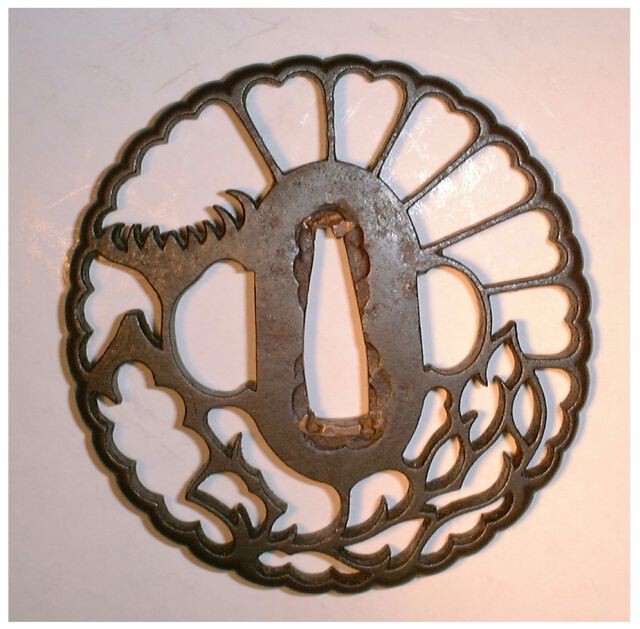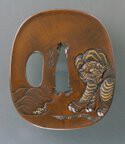-
Posts
815 -
Joined
-
Last visited
-
Days Won
1
Everything posted by docliss
-
Realising that this heavy, Meiji tsuba may not be to everybody’s taste, I should nevertheless be grateful for some help with the inscription and with a possible attribution. It is of red bronze, measuring 9.4 cm – 7.8 cm. The obverse has a delicate ishime surface with a very high relief iroye of nigurome and gold depicting DaikokÅ«, with his hammer on a golden cord. Attendant gold and silver rats are present, and there is also a shimenawa with shakudÅ. gold and silver, New Year pendants. There are four tagane-mei on the seppa-dai. The reverse is very highly polished and depicts a hon-zÅgan, shakudÅ kite on a gold string, floating above gold cottages in a low relief landscape. I have managed (I think) the following translations: JUSO with kao GENJI (KI) GINNEN KINOE NE SHUN KA (A Day in Spring, 1864) KEIDO SEN-SU (Composed by Sen-Su) ISSONDOSHI. But I have not succeeded with a further transcription above the mei. JÅ«sÅ is one of the many gÅ used by Tanaka Kiyotoshi, and the mei illustrated on p.173a-d of KinkÅ Meikan is not dissimilar to that on this tsuba, which is, I assume, gimei. With thanks, John L.
-
Dear Shan I am afraid that I can offer little help to you in your search for the makers of your two kozuka. The first is, indeed, signed MUNEHISA, and Haynes lists no fewer than 11 artists using the same kanji. Although you do not say so, this appears to be of iron, and several of the listed artists do have Miochin connections, which may be of some help. The second is, in fact, signed MASATSUNE, and this mei appears 10 times in Haynes. You can probably exclude three of these as being renowned Ishiguro artists, but you are still left with seven to choose from! Regards, John L.
-
Curran in very dismissive of KyÅ-KinkÅ as an attribution, labelling it as a ‘cop-out’ and as a ‘rag-bag attibution’; I seem to recall a previous occassion when I rebuked another member for similarly dismissing ShÅami as an attribution. But if you have a tsuba without the defining characteristics of a recognised school, and resembling KÅ-KinkÅ work but without the age, what do you then label it, if not KyÅ-KinkÅ? I am going for a KyÅ-KinkÅ attribution - and without apologies! John L.
-
This is a very interesting kantei on a beautiful tsuba. I am intrigued by the answers of Guido and Curran, and would like to hear their rationale for these. The Yoshioka school, working from the mid C17 until the mid C19, certainly had Yokoya connections, since the fourth master was a pupil of Yokoya SÅyo. But I cannot, personally, see any Yokoya influence in Eric’s tsuba. And Yoshioka work is supposed to follow the classical GotÅ style — something that cannot be said of the kantei tsuba. The vertical nanako makes one think of KÅ-Kinko work, but it demonstrates none of the flattening that one associates with this period, and is surely nothing like such an age. Examples of Yoshioka work are very difficult to find, but there is one — D 1788 — on p.310 of the Bauer Catalogue, and the high relief incrustation thereon does, indeed, bear some similarities to that on Eric’s tsuba. More, please .... John L.
-
My eyes are dim, I cannot see .... Is that vertical nanako on the plate? Thank you, John L.
-
Would any of the ‘iron men’ out there care to comment upon the attached tsuba? Thin, and measuring 7.0 cm in both height and width, it is of darkly patinated and polished iron. It is ex the Jepson collection, dispersed in 1938. John L.
-
Beautiful Kinko Mino work - I love it. Interestingly, there is a very similar image of a monkey on #3-4, p.14 in the publication of the Special Exhibition held in 1993 at the Gifu City Museum of History. John L.
-
Dear Dan Judging by the featureless quality of the iron plate and the very unworn look of the nakago-hitsu, I agree that this is late Edo work. The quality of the inlay is not good, and an attempt has been made to refine it by adding incised detail. The inlay representing vegetation is very simplistic, and the small, rectangular blocks are very reminiscent of ShÅami work — an attribution which is supported by the rather large hitsu-ana. To summarise, I think that your tsuba is late Edo, ShÅami work. Regards, John L.
-
Possibly yes Nick, but the nakago-hitsu does show very little sign of prolonged use. Additionally, the tsuba was intended to be worn with a kozuka and kogai, although it was probably an 'over the counter' purchase that happened to have both ryo-hitsu present when bought. John.
-
Dear Nick The tsuba that you have posted is an example of what are incorrectly called in the West gomoku-zÅgan tsuba, and are more correctly called hokori-yoshirÅ (dust or dirt inlay) tsuba. There are two main types of these, the first consisting of tiny snippets of brass wire affixed, at random, to an iron base and considered by some to represent twigs in a stream. The second type, of which yours is an example, consists of irregularly plaques of brass similarly treated, and these may represent clouds or melting snow. Most of this group of tsuba were produced at Yokohama for export, and are little more than 100 years old. Regards, John L.
-
Of course - how stupid of me. I do apologise for that. John L.
-
Piers raises an interesting question; of the udenuki-ana that I have seen, old or modern, all have been, without exception, on the bottom of the tsuba. John.
-
I am sorry, Piers, but I do not personally know of any such illustrations. It is quite possible that some other member may do so, however. The principle was similar to that of the European sword knot, of course. John.
-
Dear James The two small holes in your tsuba are called udenuki-ana. Usually with one smaller than the other, these were present on older guards for the passage of a cord to prevent the sword from slipping from the owner's hand. In later tsuba, such as your's, these are present simply as a design feature and were surely not used for this purpose. Regards, John L.
-
Brian The 'before' and 'after' pictures that I posted were Ford's, and try as I might, I could not enlarge them to an acceptable clarity. If you are able to post the other four images, I would be most grateful and, if not, I will take some more photographs myself. Ford will be better able to tell you details of his tecnique, but I believe that the differing colouration is caused by the different metal's reaction to a the single patination process. Correct me, Ford, if I am wrong in this. The link to Ford's photographs is: http://picasaweb.google.com/tsubaman/TsubaJohnLissendon?authkey=tC9xgpEclhw John.
-
-
I have just received three sentoku tsuba which Ford Hallam has repatinated for me. Before his ministrations these were raw brass in colouration – due, I think, to the use by a previous owner of WD40! I have attached ‘before’ and ‘after’ images of the tsuba, from which you will appreciate the excellent results obtained for a very modest charge. Ford’s work is very highly recommended. John L.
-
I am delighted by the response to my recent "Kaneie" posting, but fear that I can add little information about the tsuba. It was acquired by its previous owner in 1936, but I have no information from whence it came. It had suffered some fire damage, from which it only just beginning to recover, and this makes it difficult to date, but I favour a period somewhat earlier than Curran's "late Edo". I am supported in this by the dark colouration of the copper sekigane, which have failed to brighten in spite of my ministrations. I also favour a Kaneie appellation rather Ford's Yasuchika one. I am particularly interested in the fact that it has remained mumei; had it a gimei signature it would merely have been one of those many Kaneie forgeries. I think that Curran's suggestion of Aizu Shoami is probably correct, but many verified Kaneie tsuba also appear to have equally wide ryo-hitsu. With thanks, and kind regards, John L.
-
This is a thin, darkly patinated, mumei iron guard measuring 8.2 – 7.5 cm. Tsuchime-ji, and with an uchikaeshi mimi, it depicts, in low relief engraving, a moored punt with a thatched cover and a gold T-pole. There are low relief vegetation and wave forms, with sparing, gold decoration and, above this scene, a silver moon shines above a low relief mountain range. On the reverse are more, low-relief waves. The sekigane are very deep brown in colour, and are possibly of nigurome. Your comments, please .... Regards, John L.
-
Dear Aldwin The tsuba that you have posted is an example of the poor quality, Hikone-bori work that was extensively produced during the late Edo perion by shiiremono makers. The inscription reads HIKONE (NO)JU. A copy of Soten work, this tsuba has never been mounted, and I suspect that it may be cast. Regards, John L.
-
Thank you Milt - an interesting link and reference to Hanabusa Itcho. John.
-
Dear Chris I believe that your tsuba is a simple representation of a shitake mushroom, and bears a resemblance to tsuba with a similar theme that were produced by the Kinai of Echizen school. You will see some illustrations of such tsuba in an excellent paper on that school to be found at: http://www.users.on.net/~coxm/9.%20tsuba%20iii.html Regards, John L.
-
Thank you so much for your prompt reply. John.
-
Would a kind member please refine my reading of the mei on the attached tsuba, depicting a householder on the eve of settsubu. I have managed HIDEKAZU CHO YEGAKU TOSHINAGA TSUKURU, presumably an acknowledgement by the artist of a drawing by Hidekazu. With thanks for your anticipated expertise, John L.
-
Dear J (? John) I believe that your tsuba illustrates JŠand Uba, the subjects of a NŠplay, ‘Takasago’, by Kwanami Motokiyo. These are the Spirits of the Pine Trees of Takasago and of Sumiyoshi in the form of an old woman with a broom and an old man, normally shown with a rake. Having grown old together, they sweep away the pine needles from beneath their respective trees as a married pair, although far apart. They are a popular subject of Japanese art, as a symbol of longevity and of happy old age. (Edmunds, Pointers and Clues ... ) In my personal opinion, your tsuba is probably late C18 – early C19 Nara work. Regards, John L.
















